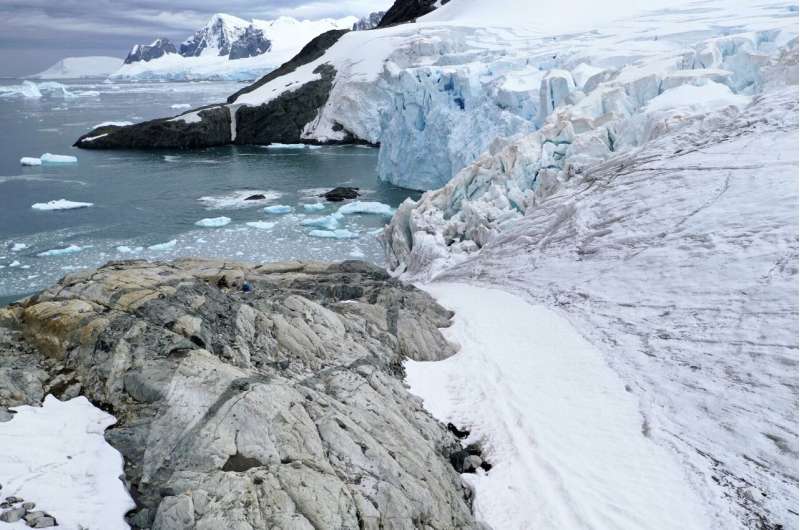This article has been reviewed according to Science X's editorial process and policies. Editors have highlighted the following attributes while ensuring the content's credibility:
fact-checked
peer-reviewed publication
trusted source
proofread
Study details timing of past glacier advances in Northern Antarctic Peninsula

Receding glaciers in the northern Antarctic Peninsula are uncovering and reexposing black moss that provides radiocarbon kill dates for the vegetation, a key clue to understanding the timing of past glacier advances in that region.
A University of Wyoming researcher led a study that determined the black moss kill dates coincide with evidence of glacier advances from other studies that found such events occurred 1,300, 800 and 200 calibrated years prior to 1950.
"We used radiocarbon ages, or kill dates, of previously ice-entombed dead black mosses to reveal that glaciers advanced during three distinct phases in the northern Antarctic Peninsula over the past 1,500 years," says Dulcinea Groff, a postdoctoral research associate in the UW Department of Geology and Geophysics.
Groff was lead author of a paper titled "Kill dates from re-exposed black mosses constrain past glacier advances in the northern Antarctic Peninsula" that appeared Jan. 20 in Geology, a journal that publishes timely, innovative and provocative articles relevant to its international audience, representing research from all fields of the geosciences.
Researchers from Lehigh University, the University of Hawaii-Manoa, and Northeast Normal University and the Chinese Academy of Sciences, both in Changchun, in the Jiln Province of China, contributed to the paper.
Mosses are one of the few types of plants living in Antarctica and can become overridden and killed by advancing glaciers. The timing of when the glaciers killed the moss provides an archive of glacier history, Groff says.
For example, when glaciers expand or advance, they can entomb or cover the plant. This starves the plant of light and warmth. The date the plant died is the same time the glacier advanced over that location.
"As glaciers recede, these previously entombed mosses are exposed and are dead and black," Groff explains. "What's so valuable about these kill dates compared to other records—like the ages of glacial erratics or penguin remains—is their accuracy. They provide a clearer picture of the climate history owing to their direct carbon exchange with the atmosphere and decreased error around the age estimate."
Glacial erratics are glacially deposited rock that differs from native rock to a specific area.
The terrestrial cryosphere and biosphere of the Antarctic Peninsula are changing rapidly as "first responders" to polar warming, Groff says.
"We know, from other studies, that large glaciers of the Antarctic Peninsula are responding quickly to warmer summer air temperatures, and scientists have modeled that the glaciers expanded in the past because of cooler temperatures, and not increased precipitation," Groff says. "However, we know much less about how this plays out at sea level where ice, ocean and sensitive coastal life interact. Knowing when glaciers advanced and retreated in the past would improve our understanding of biodiverse coastal ecosystems—thriving with seals, penguins and plants—and their sensitivity in the Antarctic Peninsula."
Groff says one of the limitations of reconstructing glacier history is that there are few types of terrestrial archives that can be used to constrain past glacier behavior. Dead plants that have been reexposed, abandoned penguin colonies and rocks can be dated to better know the timing of permanent snow or glacier advance in the past.
During the summers of 2019 and 2020, the research field team, which included Groff, collected black mosses from Robert Island, Anvers Island, Charles Point and Cape Rasmussen, according to the paper. The group inspected and cleaned 39 black moss samples.
"We collected black mosses around the northern Antarctic Peninsula by exploring the edges of glaciers and nunataks at several locations. By radiocarbon dating the mosses, we found that glaciers advanced three times in the past 1,500 years," Groff says. "This is evidence for phases of cooler and potentially wetter conditions than today."
On Anvers Island, Groff says the group learned that the last time the glacier was at its 2019 position was around 850 years ago as it expanded over the course of several centuries.
"Our estimates of glacier advance are much slower than recent retreat," she says. "Interestingly, we found that the glacier front with the fastest advance also had the fastest retreat, suggesting that hotspots of rapid coastal glacier dynamics occur in the Antarctic Peninsula."
Groff says the dataset her research group has compiled is unique, citing it's rare to have past net advance rates in the literature because glacial records tend to be destroyed when the glacier advances. Thus, these black mosses can reliably be used to estimate glacier advances in the past.
"There are other lines of evidence that support our moss kill dates for past cooler conditions such as peat records indicating lower biological productivity, as well as evidence for sea-level change from raised beaches as a result of changing ice mass," she says. "It's also possible that the climate conditions that led to glacier advances involved wetter conditions and would have had a negative impact on penguins, as we know they do today. Many of the recent abandoned penguin colonies are the same age as our youngest black moss."
More information: Dulcinea V. Groff et al, Kill dates from re-exposed black mosses constrain past glacier advances in the northern Antarctic Peninsula, Geology (2023). DOI: 10.1130/G50314.1
Journal information: Geology
Provided by University of Wyoming




















